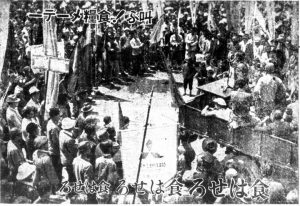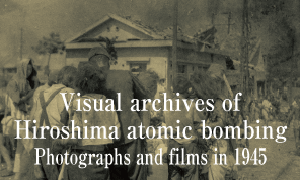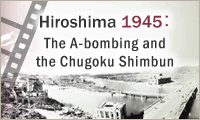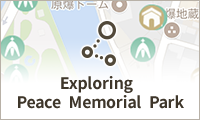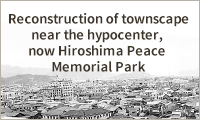Documenting Hiroshima of 1946: May 26, May Day rally calls for supply of more food
May 26, 2025
by Maho Yamamoto, Staff Writer
On May 26, 1946, a May Day rally for food was held in an open square in front of Hiroshima Station. More than 1,000 people from corporate labor unions, farmers’ associations, and war victims’ federations took part in the gathering. At a time when food shortages were worsening across the country, the rally participants called on Hiroshima Prefectural Governor Tsunei Kusunose to provide school lunches and distribute food rations.
Participants adopted a resolution addressed to the governor as five trucks of the occupation forces looked on. The resolution called for such measures as the provision of school lunches to children; the distribution of food rations especially to infants, pregnant women, and nursing mothers; the disclosure of information on the volume of rice stocks in the prefecture; and the exposure of hoarded rice by landowners, agricultural associations, and government officials. The May Day rally also served as the inaugural organizational meeting of the Hiroshima Prefecture Democratic People’s League, which was critical of the prefectural government, and included a march to the prefectural offices.
The Chugoku Shimbun reported on the May Day event the following day under the headline “Feed us, feed us, feed us,” accompanied by a photograph. The May 30 edition of the newspaper carried the results from a survey of citizens that asked questions about what people were eating. A teacher at a national school responded to the survey that he was eating rice gruel with pieces of greens or daikon radish, containing “only a few grains of rice.” A man working for the Hiroshima Railroad Bureau who was living with his family of five responded that the food rations were insufficient, complaining that life was difficult because they were forced to “buy food on the black market.”
In early May, the Hiroshima City government’s agriculture and fishery division issued a forecast stating, “We believe rice stocks will be used up by around July,” and encouraged farmers to grow vegetables such as Japanese kabocha pumpkin instead of rice on the land left barren by the war. In a notice dated June 28, Hiroshima City Mayor Shichiro Kihara expressed concern that food shortages in the prefecture by the end of July would amount to around 52,000 koku (or 7,800 tons), equivalent to a 15-day supply of food for the prefecture’s residents.
Starting in June, a prefecture-wide campaign to overcome the food crisis was launched. According to Hiroshima Shinshi (in English, ‘Hiroshima’s recent history’), published in 1983, the prefectural government had asked agricultural villages and regions in the area to cooperate in the transport of rice. The city government had organized a blacksmithing team to repair farming tools and sent them on tours of rural communities.
(Originally published on May 26, 2025)
On May 26, 1946, a May Day rally for food was held in an open square in front of Hiroshima Station. More than 1,000 people from corporate labor unions, farmers’ associations, and war victims’ federations took part in the gathering. At a time when food shortages were worsening across the country, the rally participants called on Hiroshima Prefectural Governor Tsunei Kusunose to provide school lunches and distribute food rations.
Participants adopted a resolution addressed to the governor as five trucks of the occupation forces looked on. The resolution called for such measures as the provision of school lunches to children; the distribution of food rations especially to infants, pregnant women, and nursing mothers; the disclosure of information on the volume of rice stocks in the prefecture; and the exposure of hoarded rice by landowners, agricultural associations, and government officials. The May Day rally also served as the inaugural organizational meeting of the Hiroshima Prefecture Democratic People’s League, which was critical of the prefectural government, and included a march to the prefectural offices.
The Chugoku Shimbun reported on the May Day event the following day under the headline “Feed us, feed us, feed us,” accompanied by a photograph. The May 30 edition of the newspaper carried the results from a survey of citizens that asked questions about what people were eating. A teacher at a national school responded to the survey that he was eating rice gruel with pieces of greens or daikon radish, containing “only a few grains of rice.” A man working for the Hiroshima Railroad Bureau who was living with his family of five responded that the food rations were insufficient, complaining that life was difficult because they were forced to “buy food on the black market.”
In early May, the Hiroshima City government’s agriculture and fishery division issued a forecast stating, “We believe rice stocks will be used up by around July,” and encouraged farmers to grow vegetables such as Japanese kabocha pumpkin instead of rice on the land left barren by the war. In a notice dated June 28, Hiroshima City Mayor Shichiro Kihara expressed concern that food shortages in the prefecture by the end of July would amount to around 52,000 koku (or 7,800 tons), equivalent to a 15-day supply of food for the prefecture’s residents.
Starting in June, a prefecture-wide campaign to overcome the food crisis was launched. According to Hiroshima Shinshi (in English, ‘Hiroshima’s recent history’), published in 1983, the prefectural government had asked agricultural villages and regions in the area to cooperate in the transport of rice. The city government had organized a blacksmithing team to repair farming tools and sent them on tours of rural communities.
(Originally published on May 26, 2025)

